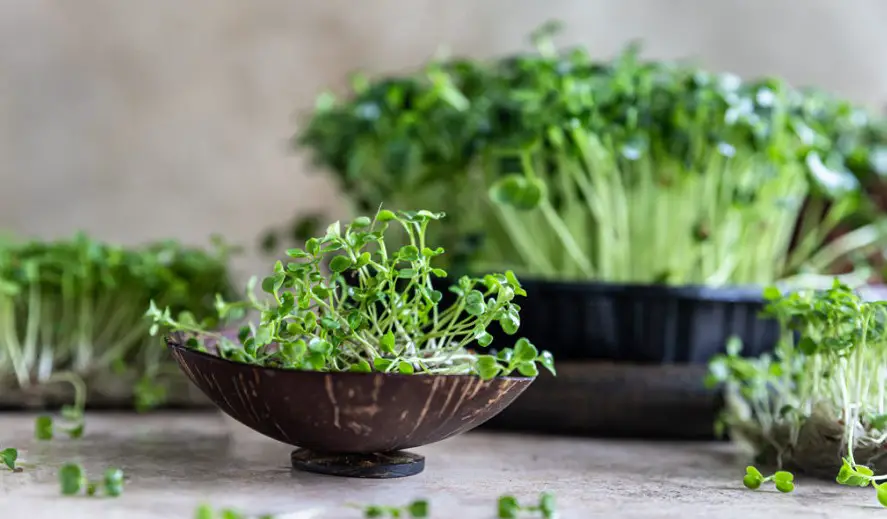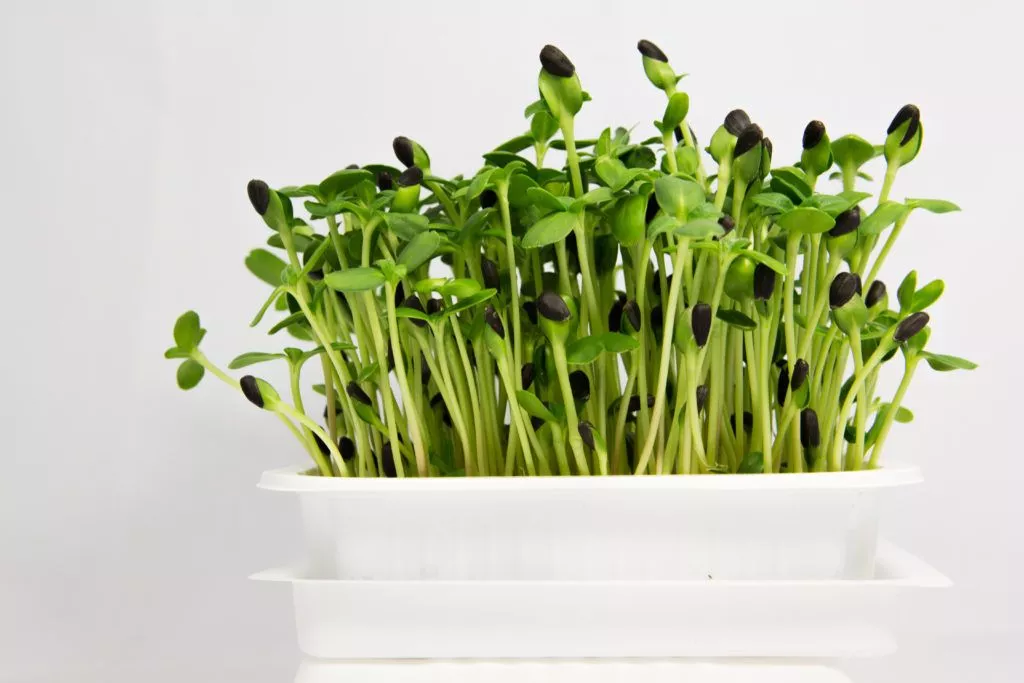With the world population closing down on 8 billion, the issue of space is becoming more and more relevant. Thus, small forms are trending in many areas: mini pets, mini plants, tiny apartments in big cities… And smaller versions of herbs and vegetables or microgreens. There are a lot of them nowadays, so we made a poll among the restaurant chefs, and they chose the top 10 winners.

Why are microgreens popular?
Microgreens are very popular in restaurants throughout the world. They look cute and taste great. They give classical dishes a modern twist and carry an aura of a healthy lifestyle, which is so critical in our time.
Why are microgreens popular?
We’ll tell you about the most popular microgreens for the chefs of the best restaurants in different parts of the world.
As you’ll see, they are inspired not only by the taste of the microgreens, but also by their appearance.
They make beautiful dish presentations and add flavor and aromas.
The most popular microgreens for chefs
Arugula microgreens
This plant is called a Superfood for a reason. It’s a source of antioxidants and vitamins A, B, C, and E. Arugula microgreens are also a great source of vitamin K.
Their nutty flavor makes the microgreens a very potent addition to various dishes. Add them to salads, and they will feel more nourishing. Put them into a pasta sauce as a spicy accent, or make them the main component of the pesto.
These microgreens grow very fast. You can harvest it after about 10 days.

Basil microgreens
One of the most famous herbs in the world has its mini version too.
Basil is an essential part of the Mediterranean diet, which is well-known as one of the healthiest in the world.
It contains iron, magnesium, vitamins A and K and other magic components.
Basil microgreens have a strong basil flavor with a little lemon twist — both sweet and sour. Its leaves are deep green, and they create a beautiful ensemble with dishes of Mediterranean cuisine.
Basil microgreens can be used in an unlimited variety of dishes. In salads, pasta dishes, meaty main courses… And who doesn’t know the classical elegance of the combination of basil with strawberries?
Their flavor is strong, but in the right bouquet with other spices, they will add bright colors to the dish.
Broccoli microgreens
Broccoli is a true treasure trove of vitamin C. Besides, it has a significant amount of vitamins B6 and D and Calcium as well. Broccoli microgreens are small shoots and represent the earliest stage of broccoli plants.
These small, tender shoots have a mild, gentle flavor and can complement lots of dishes without disturbing the primary motive. And they look cute.
Put them on a sandwich, add them to a green salad or a soup. It will always be a win — best chefs can vouch for that. You can harvest broccoli microgreens just 7-10 days after germination.

Cilantro microgreens
Cilantro microgreens are different from their ‘full-size’ variety. They grow up to 1″ – 2.5″ and are edible all the way down to the roots. Their leaves are more elongated compared to the regular cilantro leaves.
They are rich in vitamins C and A, and that undoubtedly makes them a Superfood.
Cilantro microgreens have a spicy and nutty flavor and a unique citrus aroma. As we mentioned before, all their parts are edible, with a juicy stem and soft leaves. These microgreens also have a bold and strong flavor. It’s especially great for fish and curry dishes. But you can add it to salads, soups, and salsas with a delicious result too.
Pea shoots
Pea shoots are very rich in vitamins A and K and contain a significant amount of vitamin C.
When very young, they are best eaten raw. Add them to the salad, and it will enrich the taste with the crisp texture and sweet flavor with an earthy undertone.
Pea shoots are fantastic in stir fried dishes of Asian cuisine. You can also try to substitute spinach with pea microgreens. They will bring an interesting twist to a well-known dish. Pea shoots are very popular microgreens for chefs, especially in Asian restaurants.

Kale microgreens
Kale microgreens are one of the best Superfoods. They contain an abundance of vitamins A, B, C, E, K, magnesium, iron, calcium, and lots of other vitamins and microelements.
They will be a wonderful addition to your diet, and the chefs of the best restaurants understand that too.
Their taste and texture resembles red leaf lettuce, so they will be great in salads. In some restaurants, avocado toasts are made with kale microgreens as a final signature touch from the chef.
As their flavor is very mild, they go particularly well with egg dishes. But you can make many smoothies out of them too, combining the microgreens with pineapples, mangoes, bananas, or berries. A tropical delight packed with vitamins.
Sunflower microgreens
These microgreens are rich in calcium, magnesium, and phosphorus. They also contain a substantial amount of iron, which is an extremely important element for our health.
Sunflower microgreens have a subtle flavor with a hint of nut. They have a slight crunch and will bring texture diversity to the salads. Restaurant chefs love them for that.
Adding these microgreens to the salad together with some walnuts will enhance a nutty undertone and create an unforgettable taste.
They will be great in soups, on sandwiches, in egg dishes, or with artisan cheese. The possibilities are many.

Radish microgreens
Radish microgreens provide a lot of nutritional benefits. If you incorporate them into your diet, you’ll increase the consumption of such important vitamins as A, B, C, E, and K. They are also packed with microelements critical for the proper functioning of the human body. They have a spicy flavor and a crunchy texture.
You can add them to salads, they make a great pesto and will complement sandwiches, for example salmon burgers.
Buckwheat microgreens
These microgreens bring lots of health benefits. They are rich in vitamins B and C. They also contain zinc, magnesium, copper, and manganese, improving the immunity. They have a citrus tangy flavor with a nutty undertone. This fresh taste makes them an ideal addition to salad greens.
Restaurant chefs also often use them as a perfect garnish for various dishes. These cute little sprouts are an amazing decoration.

Beetroot microgreens
Beetroot microgreens are also one of the most popular microgreens for chefs. They are extremely rich in vitamin K.
This vitamin is responsible for healing the wounds, strengthening the bones, and thinning the blood.
These microgreens are crunchy and sweet. Their green leaves and red stalks make even a simple dish look beautiful.

Final thoughts
So we’ve told you about the most popular microgreens for chefs of many restaurants around the world. You can see that it’s not just a trend for a couple of seasons. Microgreens are great for your health. Their nutritional value is exquisite. They are an amazing addition to multiple dishes, they complement traditional recipes, adding unexpected nuances and flavors.
We should also say that growing microgreens is easy. Home cooks and healthy lifestyle enthusiasts can do it and have top quality and delicious ingredients for their meals.
What is the most popular microgreens for chefs?
There are no accurate statistics about a single most popular microgreen. In the article above, we talked about top 10 microgreens. Among them are: beetroot, kale, sunflower, cilantro, radish, buckwheat, arugula, broccoli, basil, and pea microgreens.
We haven’t included mustard microgreens and red cabbage microgreens in our list, but they are also close to the top.
What is the most popular microgreen?
We don’t have any precise data about 1 most popular microgreen. But we can name a few which are in the top 10: kale, cilantro, arugula, broccoli, buckwheat, radish, and beetroot microgreens.
What kind of microgreens do restaurants use?
Well established restaurants usually use a variety of microgreens for microgreen salads which look like a beautiful rainbow mix and as additions to other dishes.
What is the tastiest microgreen?
Tastes differ. If you enjoy a mild flavor, gentle accents, and subtlety, go for broccoli, kale, or sunflower microgreens. If you prefer bold, strong aromas — cilantro, basil, radish, or arugula microgreens are for you. Or just make a rainbow mix of different varieties and enjoy the rich ensemble.


